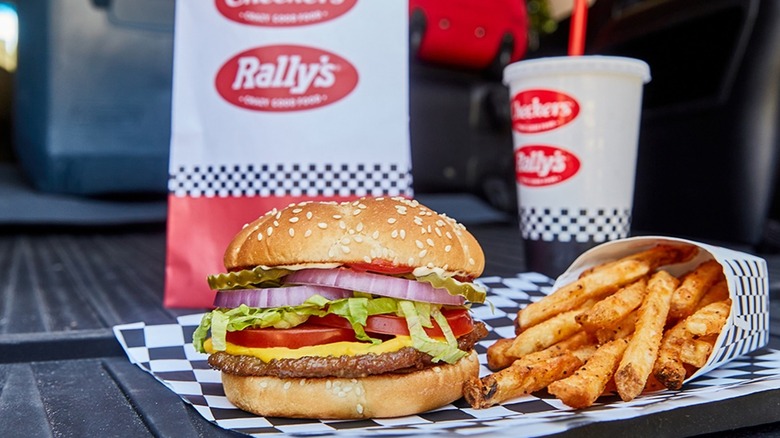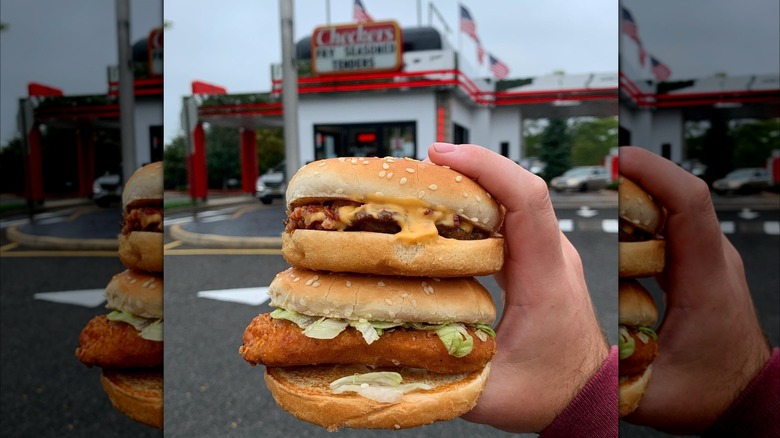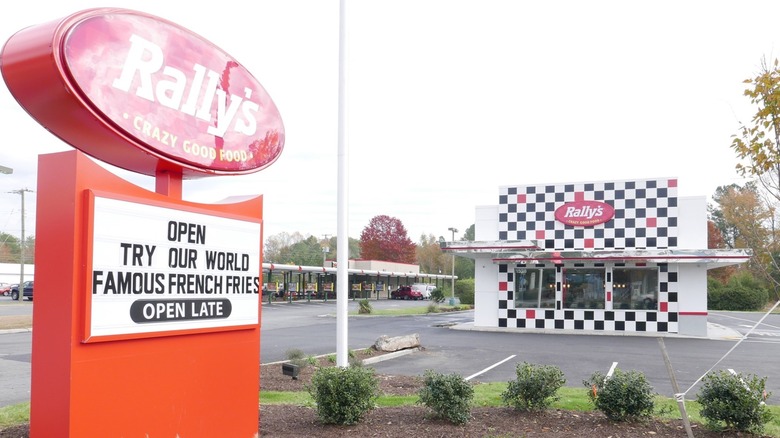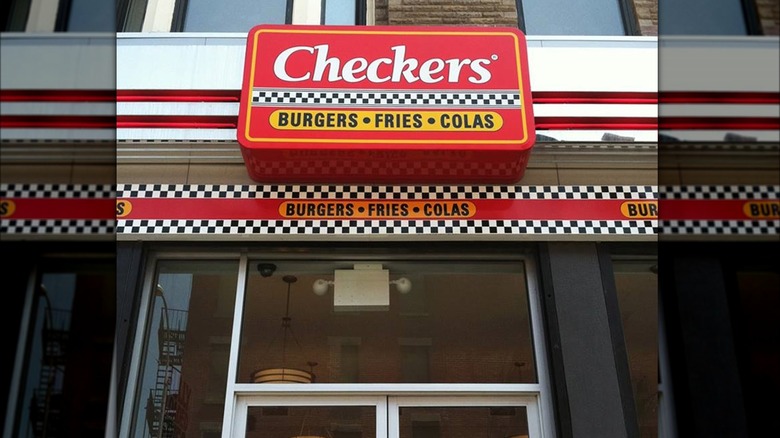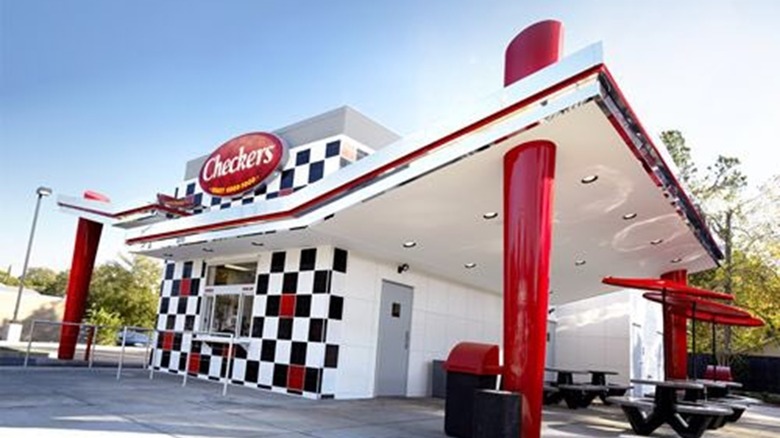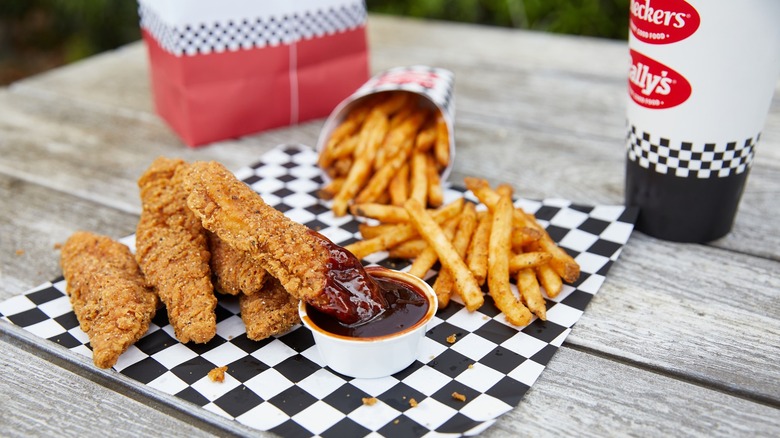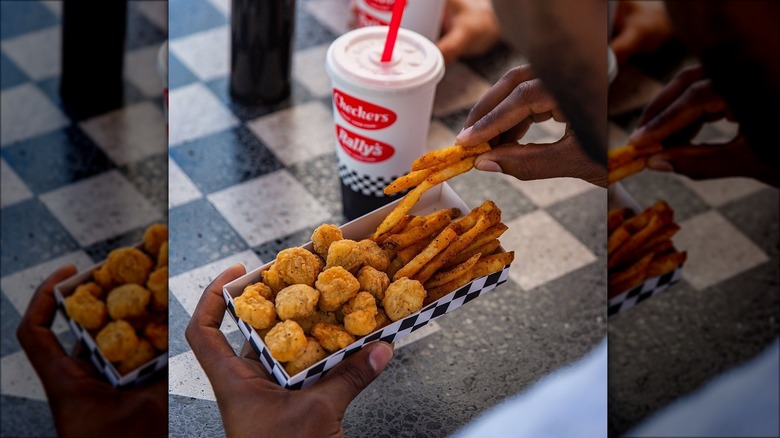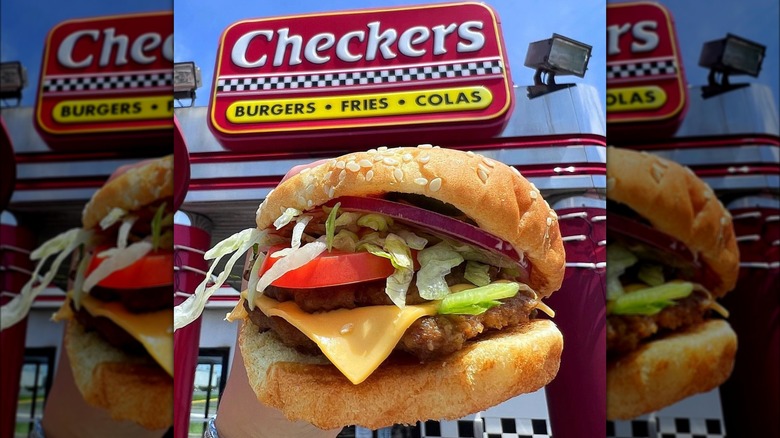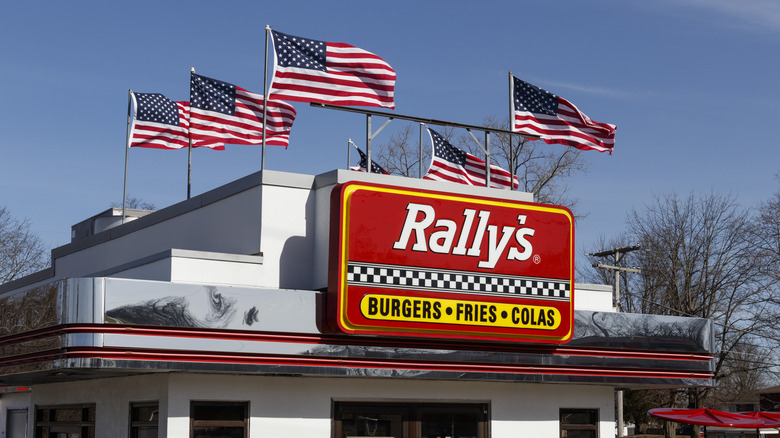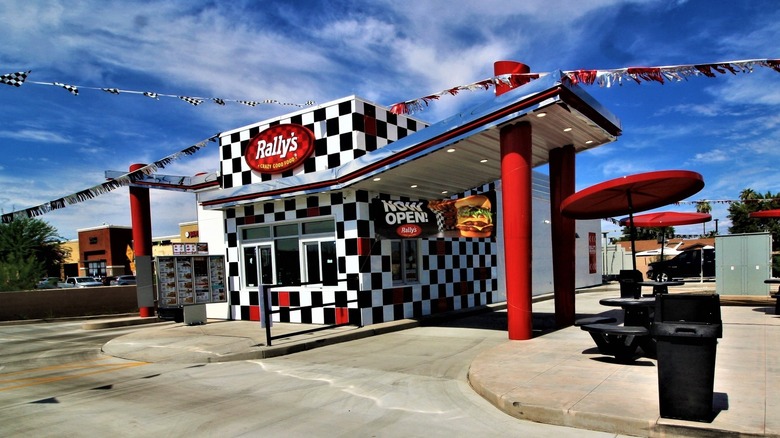How Checkers And Rally's Pulled Itself Out Of Restaurant Ruin
When Checkers and Rally's joined forces to become a singular fast-food powerhouse, it seemed like a match made on the corporate speedway, complete with checkered flags waving and crowds going wild. A pair of racing-themed restaurants coming together as a super unit on the fast-food scene may be one of the most natural business mergers ever. But after a few laps around the track, the dynamic duo of drive-thru dining hit the skids. Even with the restaurants' thematic compatibility and reasonably priced burgers-and-fries menu overlaps, some challenges made the road rougher than expected.
Though the dynamic diner-style duo is currently enjoying a renewed joyride through the casual dining terrain, the path to success was peppered with potholes that pushed the company to make several strategic moves through the decades just to survive. How did Checkers and Rally's manage to avoid the close calls and swerve around obstacles to keep trucking along as one of the country's most durable dining chains? It's a story filled with false starts and pit stops but ultimately this burger brand got back on track. We take a look at how they did it.
Both restaurants were initially successful independently
Though Checkers and Rally's both arrived on the scene at around the same time, it was Rally's that hit the track first. They barrelled out of the gate in 1985, launching its first location in Louisville, Kentucky, and in 1986, the company began offering franchise locations to expand the brand. It signaled something of a shake-up in the fast-food formula of the time, offering dual drive-thru lanes and even a walk-up window for purchasing a familiar array of burgers, fries, sandwiches, and sodas. With outdoor tables for al fresco seating, Rally's renewed the carhop stylings of the 1950s for a fresh audience. By 1996, Rally's had been purchased by CKE Restaurants, which also owned fast-food biggies Carl's Jr. and Hardees.
Checkers wasn't far behind, making tracks of its own for the big time in 1986 with an initial location opening in Mobile, Alabama. The chain offered a take on quick-casual convenience and simple fast-food offerings and even used an auto-racing theme that seemed perilously similar to the Rally's aesthetic. With a red-white-and-black palette that fit snugly in both the 1950s and the 1980s, the restaurant was off and running in the race to capture consumer dollars.
Both companies bolted through the end of the decade, finding their respective places in the restaurant world. Business for both grew steadily as franchising helped the shared concept turn a crucial corner.
The two companies merged in 1999, but trouble was on the horizon
As successful competitors are apt to do, Rally's and Checkers ultimately realized they could team up and maximize their combined successes by selling more of their popular sandwich lineup as a single unit. In 1999, Checkers bought Rally's from CKE Restaurants sold Rally's, facilitating the alignment of the doppelgänger diners. Eventually, branding decisions were ironed out and it was decided both names would be the way to go and Checkers and Rally's was born.
With the menus matched up between regions, Checkers and Rally's could step on the gas and take the concept into its next phase. There were 427 Checkers and 427 Rally's locations at the time, an even match, making a total of 936 restaurants. But the early 2000s proved difficult, thanks to a rush to expand that proved to be taxing to the company. Things came to a screeching halt in 2002 when the company reported losses totaling $1.7 million. The Checkers-Rally's combo needed assistance if it was going to complete another lap.
The race-themed restaurant rebounded in 2003
The conjoined fast-food cohorts didn't stay out of the race for long. Profits began flowing again in 2003, thanks to several strategic branding opportunities. One of these entailed Checkers and Rally's being named the official burger of the Indianapolis 500, a stroke of marketing genius that helped then-CEO Keith Sirois earn his stripes. Sirois positioned the brand to be a ground-level burger joint that appealed to working-class sensibilities, reining in the overreach that happened after the merger led the company into dire straits. These moves helped establish stability and kept Checkers and Rally's on the inside lane toward a solid lead.
Who was this new unicorn consumer that would help turn things around? The company zeroed in on young-to-middle-aged males who ate quickly, cheaply, and on the road — in other words, a market that would soon describe just about every fast-food fan in the U.S. Despite the advent of high-protein eating plans like Atkins taking off at the time, Sirois had confidence that the menu would be compelling enough to customers just as it was, with the flexibility to change should trends cause public interest to drift.
In 2013, the company reimagined financial success with an architectural redesign
Time took its toll on the Checkers and Rally's collaboration, in the form of an evolving dining landscape where fast casual and sit-down chains dominated the track. The fast-growing, publicly-traded company was purchased by investment company Wellspring for $188 million in 2006 and taken private. Rick Silva, who'd cut his teeth in the restaurant business as a Burger King bigwig, came onboard as CEO in 2007, with hopes of expanding the company's numbers to upwards of 1500 franchise locations. The expansion included a new vision for the two drive-thru architecture, allowing for covered seating in place of the second lane. This model would be available to franchisees as a design possibility, giving the restaurants more flexibility based on owner preference.
A test run of the new layout proved successful for the company; sales for the test location soared from $750,000 to $1.2 million, staggering evidence that it was indeed time for a refresh. But just as no good deed goes unpunished, so too no growing company goes unnoticed by organizations that recognize the opportunity to make even more money.
By 2017, Checkers and Rally's had been bought and sold by two different investment firms
In a move straight out of the venture capitalist playbook, Checkers and Rally's were scooped up by Sentinel Capital Partners, an equity firm that saw potential for taking the revitalized brand even further. At this point, the company was operating 782 restaurants in regions around the U.S. — 332 were company-owned locations, while 450 were franchises. The idea was to continue the expansion of what was already working for the race-themed eateries in hopes of running at top speed through an ever-increasing field of competition.
But nothing in racing or restaurants stays steady for very long. By 2017, Checkers and Rally's was on the move again, this time being sold to Oak Hill Capital Partners for a cool $525 million. The purchase allowed for an infusion of $20 million, allowing the company to continue on a steady streak of success. At the time of Oak Hill's purchase, the company had grown to include 836 locations, continuing to prove the need for fast food sold in a fun format.
The drive-thru design helped the company adapt to pandemic challenges
When COVID-19 found its way to the U.S. and brought communal business everywhere to a standstill, the call for food that could be delivered without needing reservations or table service became paramount. Though not by intentional design, the layout of both Checkers and Rally's locations proved to be a perfect solution to a market in need. It was a fortuitous twist in a perilous time that allowed the company to pivot at a crucial moment allowing them to race forward during the unfortunate developments brought about by the COVID-19 pandemic.
Though the company prospered, the gains weren't all financial. Providing access to fresh food in a non-seating environment became an essential service that gave customers options that other restaurants couldn't offer. This type of eatery allowed franchisees to keep their cash flow and maintain employment for their staff. So while it wasn't intentionally built for answering the call, the structure of the restaurants allowed Checkers and Rally's to step up when needed.
CEO Rick Silva departed to helm Culver's in 2021
Though still finding its way in a post-pandemic world, Checkers and Rally's saw its CEO Rick Silva rev his engine and roar off down other roads, taking on the same role at Culver's in 2021. He had seen the company through several major sales and purchases and helped it through the most trying times during a pandemic shutdown. In an interesting turn of events, a clip of Silva's 2012 episode of "Undercover Boss" resurfaced, showing the head honcho keeping a misbehaving manager in check and championing the workers at a Philadelphia location. It was a fitting reminder of how the leader had kept the company on the straight and narrow during his time behind the wheel.
Even with so much fluctuation, Checkers and Rally's was able to add 53 new locations to its expanding map in 2022. But growth is never guaranteed, and economic forces like inflation and wage struggles among working-class customers were bound to throw Checkers and Rally's for yet another loop.
The company changed hands to avoid bankruptcy in 2023
Growth is good, especially for investor groups looking for sure-fire successes to (literally) capitalize on. With 2023 came another uptick for the Checkers and Rally's team, in the form of a buyout by Arbor Lane Capital Management in 2023. This upshift in ownership helped reposition the fast-food favorite by reducing a $300 million debt to $75 million and allowed the company to sidestep the possibility of filing for bankruptcy. Rather than helping with growth, this time the investment intervention kept the popular restaurant chain from crashing and burning.
Checkers and Rally's CEO Frances Allen emphasized the company's ability to reinforce its financial position as it heads into a future filled with new growth, in the form of an additional 40 to 50 locations that were planned for 2023. But with more change blowing in the wind, Allen announced plans to step down from her position as CEO in April 2024, opening a spot for a new visionary to take the organization toward the next mile marker.
A trendsetting model helps the company stay ahead of the pack
There was nothing new about the carhop-and-drive-thru style of fast-food service when both Checkers and Rally's employed it in their mid-80s launches. Brands like A&W and Mel's Diner had planted their flags on the scene in the middle 20th century, offering diners on-the-go the opportunity to eat out while eating in, thanks to the absence of indoor seating. In what continues to be a lasting legacy, Checkers and Rally's set the stage for Sonic to carry on the tradition of fast-food sans seating, keeping overhead and maintenance down while providing unique modern moments filled with wistful nostalgia. The company has also been able to hold its own against competitors like Wendy's and Mcdonald's by being able to turn on a dime.
Heritage comes with a commitment to evolve as the times demand, and as the 21st century rolls forward at top speed with new leadership on the horizon, it remains to be seen if Checkers and Rally's will race into the future with flags flying. If the past is an indicator of the future, it's safe to say the wheels are far from falling off.
